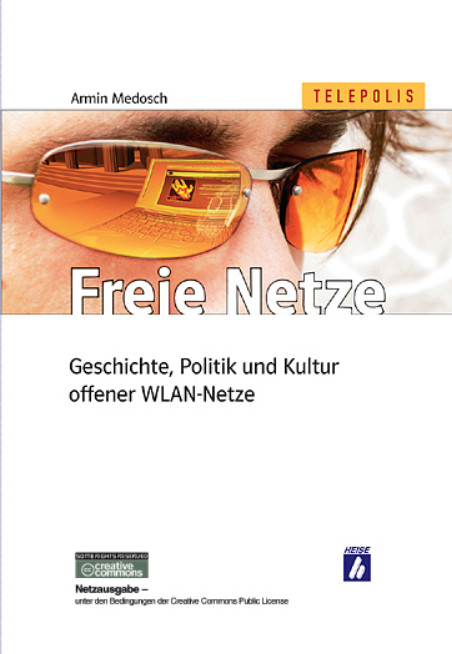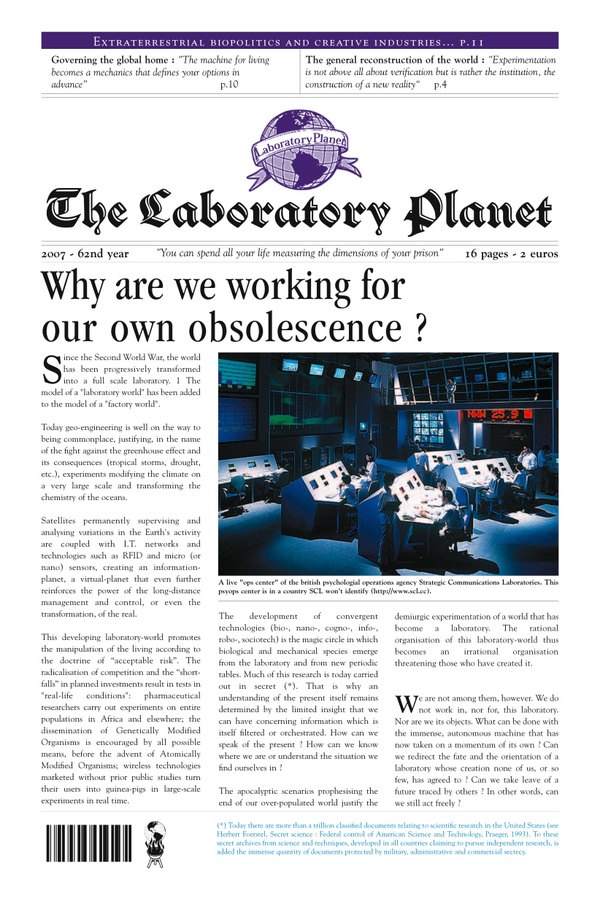Reclaim the Spectrum catalogue (2006) [Spanish/English]
Filed under catalogue | Tags: · electromagnetism, open spectrum, wireless networks

The radio spectrum – the electromagnetic space through which radio and TV broadcasts, mobile phone and GPS signals and WiFi networks circulate – is the real estate of the information society. Its invisible infrastructure is the largest engineering project in the history of man; its gradual colonisation and conquest throughout the 20th century has radically transformed the structure of society, the shape of cities and the relationship between individuals.
In spite of this, there’s a lot we don’t know about the spectrum: who owns it, how it’s managed, who decides how it’s used. Although supposedly a scarce and valuable resource, discussion about the spectrum is not a political priority and its regulation is rarely subject to public scrutiny. While the “Lords of the Spectrum” (the military, broadcasting industries, telecommunications providers) have enjoyed exclusive rights to the most useful frequencies for decades, the comparatively insufficient public frequencies have produced some of the most socially beneficial innovations, such as wireless Internet networks. From many different areas, there is an increasing demand that we begin to understand and manage the frequency system as public space, because we are increasingly taking more and more social processes and dynamics out of the streets and into the airwaves.
Now that contrary standards such as third-generation mobile phone services and wireless are competing for the same users, it is becoming an urgent priority to reclaim the right to make decisions about the most socially fruitful uses of the spectrum. Are more TV stations and video messages on our mobiles really what we need? Do we want technologies that allow us to be participants, or just consumers?
Artists, designers and activists are being the first to make the leap to appropriate Hertzian space and rework it to subvert its ends. Sometimes, by making what occurs in the realm of the airwaves visible, and mapping it to show how in the spectrum the borders between public and private space blur. In other cases, by encouraging the use of wireless networks to create active location-based communities, as used to happen in public squares or parks. And in almost all cases, by showing how our current use of the spectrum depends more on political and commercial decisions than in the full reach of its technical potential.
Somewhere in between the utopian discourse of those who want a commons of the airwaves and those who subvert and hack communication protocols and devices in total rejection of the controlled use of this technology, those who reclaim the spectrum are anticipating a political and social debate that was missing in the 20th century and cannot be postponed in the 21st.
Texts by José Luis de Vicente, Erich Berger, Julian Bleecker, Jonah Brucker-Cohen, Usman Haque, Anab Jaim, Jill Magid, Michelle Teran, and Rubén Díaz ZEMOS98.
A project by José Luis de Vicente for zemos98.
Catalogue edited by Rubén Díaz
Published under a Creative Commons BY-NC 2.5 license.
Armin Medosch: Freie Netze. Geschichte, Politik und Kultur offener WLAN-Netze (2004) [German]
Filed under book | Tags: · internet, media, network culture, networks, open spectrum, politics, wireless networks

“In den letzten zwei, drei Jahren entstand eine Bewegung, welche die klassische Idee der Freenets, der freien Bürgernetze, mit der Technologie für Wireless Local Area Networks (WLAN) zu verwirklichen versucht. Diese freien drahtlosen Bürgernetze, engl. Wireless Community Networks bzw. Free Networks, die gleichzeitig spontan in New York, London, Seattle, Berlin, Hannover und weiteren Städten entstanden sind, bieten sich als alternative Modelle für eine nachhaltige Informationsökonomie an. Interessante Themen – Stichworte mobiler Lebensstil, War-Driving, Netz-Kartographie, Selbstorganisation und Dezentralität – werden aus einer Insiderperspektive spannend und lebensnah vermittelt.”
Publisher Heinz Heise, Hannover, 2004
Creative Commons BY-NC-ND 2.0 DE License
ISBN 3936931100
240 pages
PDF, PDF (updated on 2015-7-23)
Comment (1)The Laboratory Planet, 1-4 (2007-2011) [English/French]
Filed under magazine | Tags: · control society, human rights, open spectrum, politics, security, surveillance, tactical media

“The Laboratory Planet is a periodic journal of philosophy, science and critical writing on technology. It is published in two versions, English and French, both as print and internet editions. Ewen Chardronnet, Michel Tibon-Cornillot and Bureau d’études, produce Laboratory Planet with a team of artistic researchers, philosophers, scientists and activists. As a journalistic multimedia piece, its online platform discusses geostrategic and tactical media as well as speculative issues lurking behind the ambiguous headlines of the mainstream press.”
Issue 1: Why are we working to our own obsolescence? (2007, English, updated on 2017-12-4)
Issue 1: Pourquoi travaillons nous à notre obsolescence? (2007, French, updated on 2017-12-4)
Issue 2: Hope is not needed to act (July 2008, English, added on 2017-12-4)
Issue 2: Il n’est nul besoin d’espérer pour entreprendre (July 2008, French, updated on 2017-12-4)
Issue 3: The laboratory planet or the terminal phase of nihilism (September 2008, English, updated on 2017-12-4)
Issue 3: La planète laboratoire ou la phase terminale du nihilisme (September 2008, French, updated on 2017-12-4)
Issue 4: La conquète de la Terre par les ordinateurs (October 2011, French, added on 2013-8-1, updated on 2017-12-4)
See also Issue 5.

